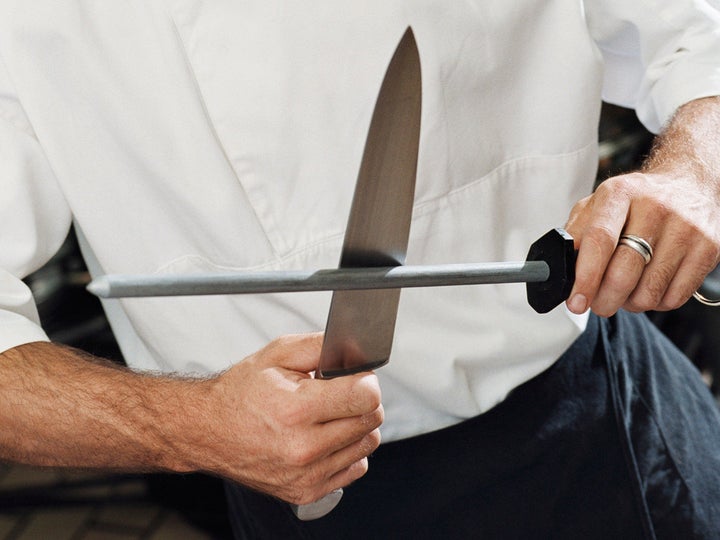
Any cook knows that a sharp knife is the workhorse of the kitchen -- without one you can't really do anything. If you've ever watched Top Chef, you'll remember an episode in Season 8 where the contestants weren't allowed to cook with knives for a Quickfire Challenge. It was practically impossible.
Even with the best knife on the market, it's no good unless it's sharp. But not everyone sharpens their knives regularly -- or even at all. If you cook every day, you should be sharpening your knives every week. If you don't cook as often, then every second week. To get into the hang of sharpening your knives, we've got some tips.
Electric sharpeners are probably the worst tool for sharpening a knife -- they strip too much metal from the knife, destroying the blade. Don't even think about using them. Handheld sharpeners are okay, but they're not the best. Whetstones (also known as sharpening stones or water stones) are the preferred tool for sharpening knives because they give you, the cook, complete control. Sharpening stones are basically long, rectangular blocks of composite stone, typically with a coarse grit on one side and a fine grit on the other side.
Start by soaking the stone (see one in the video below) for about 10 to 20 minutes in water, which will help lubricate the knife as you sharpen. Place the stone on a towel or mat with the coarse side up. Next, establish the knife's angle, usually anywhere between 20 and 25 degrees for European-style knives (Japanese-style knives have an angle as steep as 15 degrees). Hold the knife firmly at a 20-to-25-degree angle and slide it across the stone, away from you, starting from the tip and working toward the heel. Do about six to 12 strokes per side and repeat on the fine grit side. Wipe clean and the knife is ready to use. Test it on a tomato to see how sharp it is.
WATCH: How To Sharpen Your Knives, Step-By-Step
Most people confuse a honing steel with a sharpener. A honing steel (pictured above) does help make a knife slice better, but it doesn't sharpen a knife -- it only brings back the bevel (blade) into alignment. You should be honing your knife before every use because every time you cut, the blade goes off its alignment as it's moving against the hard surface of a cutting board. Honing will bring the knife back into working condition. (If you don't have a honing steel, surprisingly you can use the bottom of a ceramic mug!) Some newer honing steels on the market are now coated with diamond grit, which actually does minimally sharpen your knife. Be sure to replace your honing steel once it starts to wear down.
WATCH: How To Hone The Edge Of A Knife